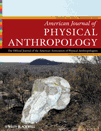Reply to Falk and Clarke on Taung virtual endocast midline and volume
The opening sentence of their letter (Falk and Clarke 2012) is simply false: “Without providing any support for their claim, Holloway and Broadfield (H & B) assert that “the Falk and Clarke (2007) reconstruction of Taung miscalculates the midsagittal plane, resulting in a significant reduction in cranial capacity….” We took their own virtual mirror-imaged endocast and showed that (1) the mirror-imaging was asymmetrical, and that (2) they never defined a midsagittal plane. We stand by these claims. Their letter now discusses in greater detail their proposed midsagittal plane, but the Figure 1 showing a dis-embodied prefrontal left petalia still does not justify choosing a midsagittal plane lacking symmetry without first carefully and explicitly defining a midsagittal plane upon which mirror-imaging is to take place. The quality of the dorsal image of Figure 1 is so poor that one cannot even make out the sagittal, coronal, or lambdoid sutures.
It is unfortunate that Science (not Nature as Falk and Clarke have it in their Literature Cited) did not publish the photographs provided for Holloway's (1970) article, because in fact RH placed the pointers at maximal distances, two along the sagittal suture, at roughly bregma, and lambda. The 3rd was placed in the middle of the midsagittal plane between the left and right superior prefrontal gyri at the most anterior part of the frontal lobe then available (longitudinal sulcus or fissure). The needle scribes lines went through the middle of the posterior part of the rostral bec, justifying the choice of midsagittal points on the dorsal surface. Implying that RH's choice of points was incorrect because the sagittal suture “meanders” is simply spurious.
Falk and Clarke make much of the Figure 2 composite of the Taung Wenner-Gren cast, and one of the reconstructions RH used to show three points in the midsagittal plane. Yes, the reconstruction piece is slightly tilted, but the point was to show three points along the midsagittal plane. Indeed, the region left of the midsagittal plane is an artifact of being a 3rd generation cast, and was not a part of the reconstruction subjected to water displacement. As indicated in the 1970 article, three reconstructions were made. The originals remain at Wits, and what RH has remaining are casts made from molds of those reconstructions, which is what appears in Figure 2. The tilt of the cast in our photograph is hardly relevant to our arguments.
We are somewhat amused at their claim regarding how much better “state-of-the-art” methods such as theirs are preferable over the crude methods employed in 1969–1970, before scans of Taung and segmenting software were available. It is somewhat disingenuous for Falk and Clarke not to have noted in proof that Neubauer et al. (2012) using “state-of-the-art” virtual endocast techniques found that Holloway's midline was accurate and that all of their volume determinations for Taung were identical to Holloway's (1970) range, i.e., about 402–405 ml. Indeed, it is almost approaching mantric proportions that somehow previous work done without the aids of CT scans, virtual imagery, and modern morphometric statistical methods is somehow suspect and worthless. We applaud re-testing older results using newer methods, but here are two examples of use of virtual endocasts and “state-of-the-art” and the bottom line is a difference of some 20 ml of volume, or roughly 5% of the total volume. Obviously, “state-of-the-art” methods are relative to the ability of researchers to choose correct anatomical landmarks, and test their own methods, something that the Neubauer et al. paper does, but Falk and Clarke do not.
LITERATURE CITED
Ralph L. Holloway*, Douglas Broadfield , * Department of Anthropology, Columbia University, New York, NY 10027, Department of Anthropology, Florida Atlantic University, Boca Raton, FL 33431.




